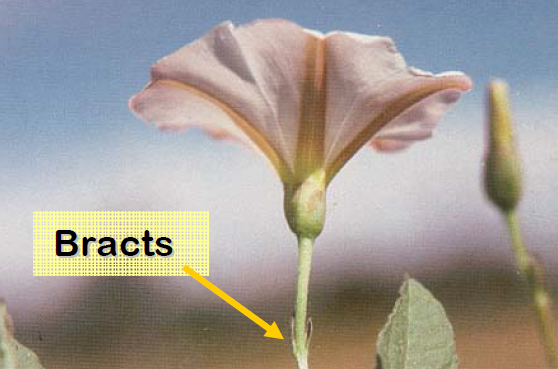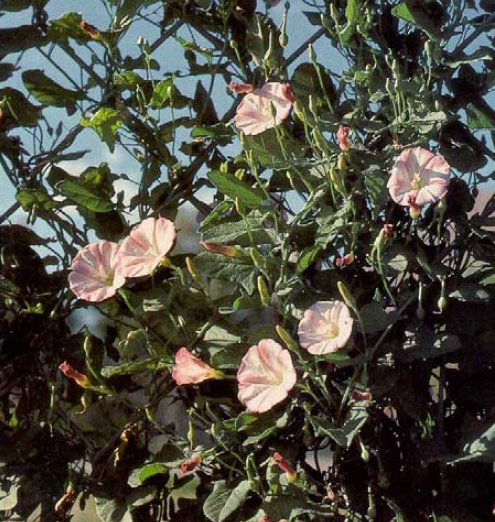Introduction
Field Bindweed (Convolvus arvensis L.) was introduced from Europe and is a serious weed in most of the United States. It is adapted to many different environments and is very difficult to control or eradicate once it is established.
Identification
Field bindweed is also called perennial morning glory and creeping jenny. This vining perennial has an extensive fibrous root system that produces new plants if cut during tillage or cultivation. The roots are whitish and fleshy. The taproot is the primary root from which the lateral roots develop. The root system may reach 20 to 30 feet laterally as an extensive underground network. The depth of the root system depends on the soil type and the amount of soil moisture present. With large amounts of available moisture, the roots are more extensive. Carbohydrates in the root system provide energy for plant growth and regrowth following winter dormancy, disturbance, or poor growing conditions. The roots build up food reserves, allowing the plant to survive underground for more than three years without replenishment.
The seedling leaves (cotyledons) are almost square, with a shallow notch at the tip. The first true leaves are shaped like an arrowhead and have leaf stems (petioles) that are flat and ridged on the upper surface. Field bindweed stems are vining and often climb other plants, structures or may form dense mats over the ground.
The leaves of mature plants are shaped like an arrowhead and are one-half to two inches long (Fig. 1). The leaves at the base of the stem are larger than the immature leaves at the end of the stem.

Figure 1. Field bindweed leaves are slender with sharp pointed lobes.
The funnel-shaped flowers are white to pink and one to one and one-half inches wide (Fig. 2). There are two small bracts on the flower stalk one inch below the base of the flower, which distinguish field bindweed from hedge bindweed. The flowering period is from June until frost in the fall.
The dark, brownish gray seeds are borne in two-celled, egg-shaped capsules, with two seeds per cell. Seeds remain viable in the soil for up to fifty years.

Figure 2. The flowers of field bindweed are white to pink and have two small bracts.
Habitat
Field bindweed is prevalent in all parts of the United States, except in the southeast. In the West, it is widely distributed in cultivated fields and waste places. Field bindweed has the ability to adapt to different environmental conditions and is found growing in a variety of locations, soils and at almost every elevation. It grows best on fertile, dry, or moderately moist soils. In Nevada, field bindweed is commonly found in waste places and along roadsides.
Impact
Field bindweed arrived in the United States as a contaminant in farm and garden seeds. It grows from seed, roots, and rhizomes. It is spread from long-lived seed and plant fragments in contaminated seed and on equipment, vehicles, water, and animals. Its deep root system competes with other plants and crops for water and nutrients.
crops for water and nutrients. Field bindweed is very persistent and difficult to control in ornamentals, crops and moist areas. Its root system, drought tolerance, and long seed dormancy are very problematic. Once established, field bindweed is one of the most difficult weeds to control and requires many years of persistent management to eradicate.

Figure 3. The attractiveness of field bindweed is a reason it was often planted as an ornamental.
Management Methods
Control of field bindweed will not be easily accomplished, but rather requires persistence and diligence. Effective control involves preventing seed production, reducing the stored carbohydrates in the root system, providing plant competition, and constant removal of top growth to prevent carbohydrate accumulation and seed production.
As with all weeds, the most effective control is prevention of its establishment. Taking action while the infestation is still small will be less expensive and most effective. Decrease the likelihood of field bindweed infestation by purchasing and planting clean, certified crop seed. When discovered, immediately remove any seedlings to prevent the establishment of bindweed.
Mechanical Control
Hand pulling seedlings or tilling young plants will have positive results. Mature plants, however, are difficult to pull without leaving fragments of roots and rhizomes that can resprout. Intensive cultivation controls new seedlings and young plants, but may spread roots and rhizomes. Control can be obtained by tilling eight to twelve days after each emergence continuously throughout the growing season. If done frequently, this will starve the roots and rid the area of new seedlings. Tilling should be at least four inches deep.
Mowing field bindweed will not effectively control the weed because of its low creeping nature and extensive roots.
Smothering the plants with spunbonded, woven, or laminated plastic fiber geotextiles will starve the roots, if the plants are deprived of light for several years. However, plastic can crack, and the vining habit of field bindweed may allow it to break through the fabrics or other opaque materials.
Cultural Control
When an infestation is young, a fallow period, especially without precipitation or irrigation, may greatly reduce the weed population.
Solarization of the soil (by moistening, rototilling, and covering the infested soil with six mil clear plastic during the hottest, sunniest time of the year for four to eight weeks) may also control this weed.
Provide field bindweed with competition by maintaining a healthy cover of perennial plants and grasses. The presence of shrubs and trees should reduce growth.
Biological Control
There is currently no evidence of a successful biological control agent for field bindweed. However, research on the use of bindweed gall mite (Aceria malherbae) and bindweed moth (Tyta luctuosa) to control field bindweed is ongoing. The gall mite has established in limited sites in Oregon and Washington, but has not demonstrated much success yet. The effect of the bindweed moth is unknown. Combining other methods, such as herbicides, with biological control will provide better results.
Chemical Control
For home landscapes, apply 2,4-D two to three times a year to suppress the infestation. Fall and spring applications are most effective, but a summer treatment may be necessary where conditions encourage growth. Do not exceed two pounds per acre per year. Triclopyr or glyphosate applied at midbloom will also suppress field bindweed. Dichlobenil applied midwinter will control field bindweed in home landscapes.
Dicamba (Banvel® or Clarity®) at a rate of one-half to one pound acid equivalent per acre (ae/A) will suppress field bindweed. That rate of dicamba may also be combined with 2,4-D at a rate of one to two pounds ae/A for containment. These herbicides should be applied during fallow periods before planting and when the weeds are actively growing.
For field bindweed control, stronger rates of dicamba can be used. In the late summer or fall before killing frost, apply one to two pounds ae/A of dicamba, or one to two pounds ae/A of dicamba combined with one to two pounds ae/A of 2,4-D. A follow-up application in the spring may be necessary to control new seedlings.
Do not apply products containing dicamba near or over the roots of broadleaf ornamental trees and shrubs or tree crops. Applying picloram (Tordon®) at a rate of one pound ae/A during the growing season on noncrop land when the plants are visible may have some results. This chemical may be most effective if applied during the early bud to full bloom stage of growth. Picloram should be applied as a coarse, low-pressure spray. This is a restricted-use pesticide, so use with caution. Only certified applicators may apply restricted use products. When applying any product, always follow the labeled instructions, it is the law!
Glyphosate at a rate of three to three and three-quarter pounds ae/A will be effective when applied at full bloom to the early seed stage of maturity. Also apply to the regrowth in the fall. Cover foliage thoroughly, but avoid spray runoff. To successfully obtain control, repeated applications may be necessary. To improve control effectiveness, till the treated area two to three weeks after application.
Applying metsulfuron (Escort®) to actively growing field bindweed in the bloom stage will suppress the weed. Use a nonionic or silicone surfactant to improve control. Metsulfuron should only be applied to pasture, rangeland, and noncrop sites.
References
- Baker, D.V., T.L. Steinke, and S.K. McDonald. Field Bindweed. Colorado State University. 6 July 2004. CSU.
- Elmore, C.L. Pests in Landscapes and Gardens: Field Bindweed. UC IPM. 1 July 2004
- Whitson, T.D., ed., L.C. Burrill, S.A. Dewey, D.W. Cudney, B.E. Nelson, R.D. Lee, and R. Parker. Weeds of the West. Jackson, Wyoming: Grand Teton Lithography, 2000.
- William, R.D., A.G. Dailey, D. Ball, J. Colquhoun, T.L. Miller, R. Parker, J.P. Yenish, T.W. Miller, D.W. Morishita, P.J.S. Hutchinson, and M. Thompson. Pacific Northwest 2003 Weed Management Handbook. Oregon State University, 2003.
- Zollinger, R.K. and R.G. Lym. Identification and Control of Field Bindweed. North Dakota State University Extension Service. 1 July 2004 NDSU.
- Photographs are courtesy of Weeds of the Wes
Graham, J., and Johnson, W.
2004,
Managing Field Bindweed,
Extension | University of Nevada, Reno, FS-04-48


